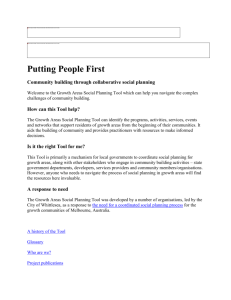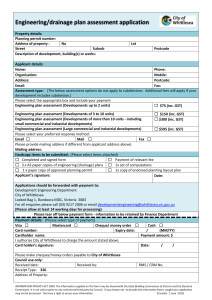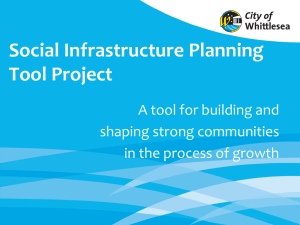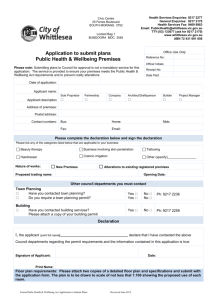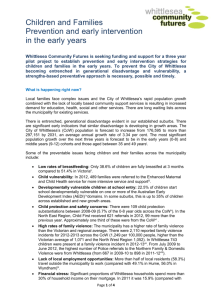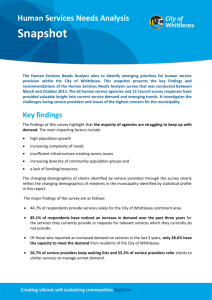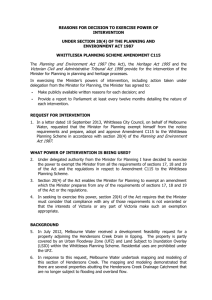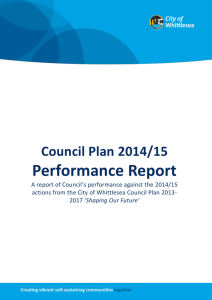Schools Information Booklet
advertisement
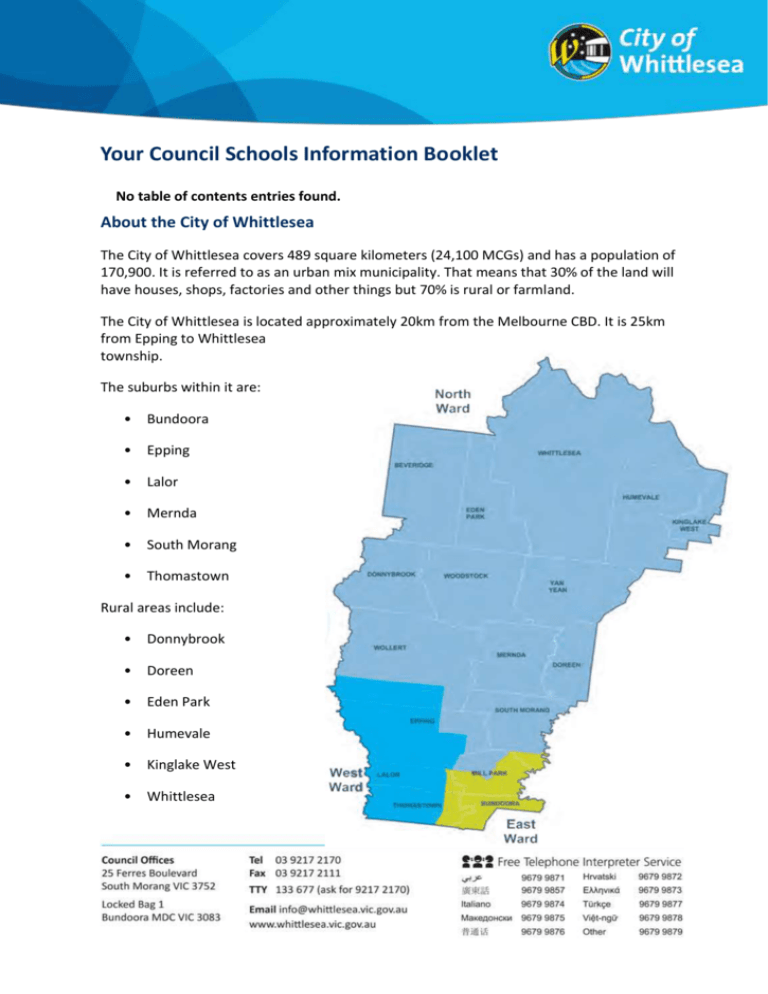
Your Council Schools Information Booklet No table of contents entries found. About the City of Whittlesea The City of Whittlesea covers 489 square kilometers (24,100 MCGs) and has a population of 170,900. It is referred to as an urban mix municipality. That means that 30% of the land will have houses, shops, factories and other things but 70% is rural or farmland. The City of Whittlesea is located approximately 20km from the Melbourne CBD. It is 25km from Epping to Whittlesea township. The suburbs within it are: • Bundoora • Epping • Lalor • Mernda • South Morang • Thomastown Rural areas include: • Donnybrook • Doreen • Eden Park • Humevale • Kinglake West • Whittlesea • Wollert • Woodstock • Yan Yean Page 2 of 17 History of the City of Whittlesea The first documented description of the Whittlesea area was dated December 1824, in the journal of Captain W H Hovell. He and the explorer Hamilton Hume had been sent to find a way from Sydney across the Great Dividing Range to Port Phillip Bay. In 1837, George Sherwin settled as a squatter at Whittlesea, then known as Upper Plenty. In 1838/9 the area was surveyed and in 1853 the surveyor, Mason, named Whittlesea after the Town of Whittlesey in Cambridgeshire, England. He also named Epping after another English town. Many other parts of the municipality retain their Aboriginal names, such as Bundoora, Morang, Toorourrong, Wollert and Yan Yean. Mason's survey set out the lines of three North-South routes - the Plenty Road, the Epping Road to Wollert and the Sydney Road, which is now the Hume Highway. The district quickly became a vital part of Melbourne's life, supplying food from its farms and water from Melbourne's first large water storage, Yan Yean Reservoir. District Roads Boards and the Early Shires There were a number of District Roads Boards formed in this area during the middle of the 19th Century, later merging to form the early shires and finally, the City of Whittlesea. On 26 September 1870, the District Roads Boards of Epping, Woodstock and Upper Plenty or Morang merged to form the Shire of Darebin. This shire stretched from Northcote to Whittlesea and the Shire Council held its meetings in Preston. The Shire of Darebin's name was changed to the Shire of Epping on 22 March 1894. The neighbouring Donnybrook and Wallan Wallan District Roads Board, later became the Shire of Merriang, then, on 1 October, 1915, became part of the Shire of Broadmeadows, now part of the City of Hume. Another of the District Roads Boards was the Whittlesea District Roads Board which had been proclaimed on 1 December 1862. On 1 January 1875, the Whittlesea District Roads Board, with the Merriang riding of the Shire of Darebin, were constituted as the Shire of Whittlesea. The newly elected Council had its first meeting in the Courthouse at Whittlesea. In 1915, the Shire of Whittlesea absorbed the Shire of Epping, and in 1988, the Shire was proclaimed a City and became the City of Whittlesea. Page 3 of 17 A Growing City Since World War II, the City has enjoyed steady growth, adding new suburbs Lalor and Thomastown in the 1950s and 1960s, and Mill Park in the 1970s. The population has quadrupled since 1969, from 29,000 to around 146,000 residents in 2009. The City of Whittlesea is one of Melbourne's major growth areas, with the population expected to reach more than 220,000 by 2030. The Whittlesea Council has the responsibility of planning a city, which will be a home, a place of work and a place to relax. Our aim is a city well-equipped with quality services and recreation opportunities for all of its residents. Our Aboriginal History Before European settlement, the Aboriginal people of the Wurundjeri Wilam clan lived on the land that now forms the City of Whittlesea and the northern suburbs of Melbourne. They lived on the offshoots of the Yarra River - along the Merri, Edgars and Darebin Creeks the Plenty River and the Maribyrnong River. There are currently between 1000 and 1500 Wurundjeri Wilam people living in Victoria. Many of the names in the City of Whittlesea were inspired by the Wurundjeri culture and traditions: Bundoora - Keelbundoora was a young boy present at the signing of the Batman Treaty Yan Yean - young boy (derived from yan yan) Mernda - young girl (derived from murnmurndik) Wollert - possum (derived from walert) Merri - place of many rocks Wallan - spherical/round (derived from walen-walen) Wurundjeri Wilam people The Wurundjeri Wilam clan is part of the Wurundjeri language group, and speaks the Woi wurrung language. The Woi wurung is one of the many language groups that make up the Kulin Nation, whose people shared the same religion and language, and lived in what is now metropolitan and greater Melbourne. Page 4 of 17 The Wurundjeri Wilam people have a strong connection to the land now known as the City of Whittlesea. They travelled the area in search of resources, fresh water, food and shelter; the Plenty River and many creeks offering various types of fish and birdlife. They held cultural ceremonies and conducted business and trade negotiations at sacred sites. Over 70 of these sites still exist in the City today, as well as many sacred scarred trees. Some Aboriginal clans believe that they are represented by native animals or a 'moiety' system. The people of the Kulin Nation were both Waang (the Australian Raven) and Bunjil (wedge-tail eagle - the creator) people. Marriage was regulated by the moiety system. Wurundjeri clan law said that there could only be marriage between different moieties. This meant that a Bunjil man could only marry a Waang woman and a Waang man could only marry a Bunjil woman. This kept the genetic variation strong. Wurundjeri language - Woi wurrung Below are some other common words in the Wurundjeri language – called Woi wurrung - and their English translation. Woi - the way we pronounce our words Wurrung - language Kulin - man/people Wurundjeri - derived from the words ‘'wurun'’ and ‘'djeri' Wurun - River Red Gum and Manna Gum Djeri - grubs; found in the River Red Gums and eaten by the Wurundjeri people Wilam - shelter/living place History of our Suburbs Bundoora Bundoora was named after Keelbundoora, which was the name of the parish (land) where Bundoora exists today. Keelbundoora was also the name of the young boy present at the signing of the Batman treaty, a historic land agreement made by European settler, John Batman with the Aboriginal people of Melbourne in 1835. The treaty was later ruled invalid by the government of the day. Only a small part of Bundoora is within the City of Whittlesea boundary, the rest of the suburb is served by Darebin City Council and Banyule City Council. Lalor Lalor was established in the early 1940s. Lalor was originally the home of a low-cost housing project which provided houses for ex-servicemen returning from World War 2. The first primary school opened in 1954. Page 5 of 17 Thomastown Probably named after the Thomas family, which bought land near what is now Main Street in 1848, the name Thomastown has been in official use since the early 1850s. The area around Thomastown has also been known at various times as Micklenbury, Dry Creek and Westgarthtown. Up until the mid twentieth century, Thomastown’s economy was predominantly farming and market gardening. Early industrial development included the establishment of a pottery in Settlement Road in 1922. The electrification of the railway line to Thomastown in 1929 prompted the subdivision of land around the railway station for residential development. However, residential and industrial development remained limited until the end of the Second World War. Epping Epping was named in 1853 reportedly after the Epping Forest in Essex, England. The first hotel was opened in 1853. The first catholic school was opened in 1844. South Morang South Morang is named after the Parish (or area) of Morang where the suburb exists today. The first primary school in South Morang was built in 1877 and the suburb boasts two major parks, Hawkestowe and Plenty Gorge Parklands. Like many other suburbs in the municipality, the former Whittlesea railway line used to run through South Morang. Whittlesea Whittlesea as the township came to be called was named after Whittlesey in England. Close to 1889 a railway from Whittlesea to Melbourne was established to transport goods produced in the region to Melbourne. The railway closed in 1959. Mill Park Mill Park was named after Henry Money Miller who bred racehorses and conducted a range of dairy and grazing activities at his property named, The Findon Hounds and the Findon Harriers Hunt Club until 1930. Residential development began in Mill Park in the 1970s. Page 6 of 17 Mernda/Doreen This area has grown from a population of 1316 in 2001 to 3430 in 2006 and is anticipated to grow to around 40,000 people at full development. The name Mernda means young girl in the local Wurundjeri Wilam Aboriginal language. When Mernda was named in 1913 the township consisted of a school, a Methodist church, a store and a railway station. In the early 1900s there were many dairy farms in Mernda who supplied milk to Melbourne. Rural North The rural north of our municipality includes the suburbs of Wollert, Woodstock, Donnybrook, Eden Park, Yan Yean, Humevale, Kinglake West and part of Beveridge. Why do we need to have governments? Without government , life becomes very difficult. Governments decide what is the best for the general good of the community. They put rules and systems in place so that people in our community can live together peacefully. Imagine living in a town where the garbage was not collected, roads were not maintained and there were no playgrounds, sportsfields, schools, hospitals or libraries. We depend on government to take care of many of these things. Each local community is different and different parts of the country have different needs. Things that are important in your town may not be relevant in another part of Australia or even to the next town. That's why we have local government to look after the needs of the local community and its people. Three Levels of Government In Australia, we have three levels of government making decisions, Federal, State and Local. All levels of government have regular elections so if people are not happy with decisions the current government is making, they have the opportunity to vote in another group of people to form a new government. The Australian system of government is often described as being democracy. To be precise we are in fact a parliamentary democracy. Democracy means rule by the people. We elect representatives for each of our three levels of government Federal, State and Local. Page 7 of 17 Federal Government The Federal or Commonwealth Government is made up of politicians from all the states and territories of Australia. Its leader is called the Prime Minister. The Federal Government looks after matters that affect the whole nation, such as: • Defence - Army, Navy & Airforce • Foreign Affairs • Customs/Trade • Immigration • Postal services • Currency State Government The state governments make decisions and rules for people within each state. Each state government has its own elections and is based in the states capital city. Victoria’s state government sits at Parliament House in Spring Street, Melbourne. The leader of the state government is called the Premier. Each state government controls its: • Education & Health • Law Enforcement • Housing Industry • Local Government • Public Transport • Power supplies Page 8 of 17 Local Government Each state is divided into regions called municipalities that are run by local government or councils. People who live in a municipality elect their council representatives democratically. The Councillors then elect a leader, the Mayor. Councils hold their meetings in a building called the Council Chambers. Local councils manage community needs including: • Health & Community Services • Planning and Land Use • Recreation & Culture • Roads/footpaths/bridges • Waste and recycling services • Parks and gardens • New building approval Page 9 of 17 Types of Councils In Victoria, all local governments are called councils. Some are referred to as city councils, while others are called shires. Although shires are usually rural, some of Victoria's outer councils still retain the title shire such as Mitchell Shire. Councillors In all councils, elected representatives are called councillors. Council has wards with a number of councillors representing each ward. The City of Whittlesea has 9 councillors. The municipality is divided into three wards (areas) and each ward has three councillors. South East Ward South West Ward Cr Sam Alessi Cr Stevan Kozmevski Cr Ken Harris Cr Kris Pavlidis Cr Norm Kelly Cr Darryl Sinclair Cr Mary Lalios Cr Adrian Spinelli North Ward Cr Rex Griffin Cr Ricky Kirkham Cr Christine Stow Page 10 of 17 Councillors are not paid a salary but receive an annual allowance to help cover expenses in fulfilling their role on Council. They generally carry out their council duties in addition to their full time job in the workforce and/or home commitments. They take on this responsibility because they want to play a part in local government and feel strongly about issues in their community. Anyone can be a councillor as long as they are over 18 and eligible to vote in state and federal government elections. Councillors are local residents and know their communities well. The main duties of elected Councillors are: • To make decisions about the running of the community and the Council • To listen to the problems and ideas of local people and take those ideas to the rest of Council. Council Elections Council elections are held once every four years. Councillors for Whittlesea are elected by residents aged over 18. Candidates who get the most votes are elected for a four year term. Each year the nine councillors vote to elect one councillor as the Mayor. The Mayor is the leader of the Council he or she is in charge of the Council meetings and represents council at formal functions. The Mayor makes sure that the Chief Executive Officer and council staff carries out council decisions. Council Meetings Council meetings are held every third Tuesday, beginning at 6.30pm in the Council Chambers situated at the council offices at 25 Ferres Boulevard South Morang. Anyone can attend Council meetings to hear what is going on or to present their point of view and watch Councillors vote on a particular issue. If there are the same number of votes for a project as against, the Mayor can use his/her vote to decide the issue. What does Council do? The City of Whittlesea provides community services and facilities using the money it raises. It is also responsible for making and enforcing local laws. Council's responsibility covers some key areas such as: Providing: many services and supporting community services Protection: ensuring the community is safe and clean Prevention: pollution, noise, disease Planning: future of community, what services will be needed Page 11 of 17 Representing: the area to other governments, to tourists and overseas visitors. Look around and you'll see your Council at work everywhere: Council staff plan and run many events such as: • Community Festival • Rockin @ Redleap • International Volunteer Picnic Day • Carols by Candlelight • Australia Day celebrations • Kids Art in the Park • Hawkstowe Music Festival • International Day of People with a Disability Council workers repair roads, footpaths, street lights and replace signs. Garbage trucks remove rubbish and recycling from our homes and businesses every week. Local Laws officers make sure people obey parking restrictions, observe fire danger periods and our pets are registered. Meals on Wheels staff and volunteers deliver low cost meals mainly to elderly people living alone. Senior Citizens centres offer retired people the opportunity to make new friends and do various activities. The school crossing supervisor works at keeping you safe. Libraries there are three in the City of Whittlesea - Lalor - Mill Park - Thomastown A mobile library also services the areas of Whittlesea, Mernda and Doreen. You can borrow any of the 14,000 items in stock, including an extraordinary range of books, videos, DVDs, magazines, talking books and large print publications. The mobile library all has internet access, 3 public PCs and a children's area. Page 12 of 17 How does Council pay for these community services? There are four main ways Council raises money: Rates Every property owner in the City of Whittlesea pays an amount to the Council each year called rates. The amount depends on the value of the property the more valuable the property the higher the rates. The property owner can pay the rates all at once or on four parts called instalments spread over the year. A property valuer working for the Council reviews the value of each property every two years. Fees People in Whittlesea pay fees for some Council services. When you go to a swimming pool, you pay an entry fee; your cats and dogs are registered each year with the payment of a fee; if you want a special rubbish collection there’s a fee; people have to pay for a building permit or for a permit to remove large trees. There are also fees called fines which are collected from people who have ignored the rules. If your library book is overdue, you pay a fine before you can borrow another one; if a dog is found wandering around the streets and taken to the pound, its owner has to pay a fine to get it back. Grants Each year the State and Federal Government collect money called taxes from Australian citizens and businesses and give some of it to local government. Sometimes these grants are for something specific. Loans Council can borrow money for larger projects and repay the loan over a number of years. However interest must be paid as well as the original amount borrowed, so this is an expensive way to raise money. How does Council decide where the money should be spent? One of the main roles of Council is to manage the money it raises and in June each year it allocates amounts of money to be spent in various areas this is called a budget. There are some things that must always be included in the budget like rubbish removal, maintenance of roads, paths, street lighting, bike tracks and parks the things that make Whittlesea a safe and pleasant place to live and work. Page 13 of 17 Council staff provide reports to council to assist Councillors in their decision making. For example, the council's engineers have the expertise to provide information on which roads require maintenance, the cost of this work in the current financial year and how much more it could cost if this work is delayed. Who does the work? Many people work for Council so it can provide its services. Council staff are not elected, they apply for their positions and are paid for their work. Whittlesea City Council has approximately 900 staff. The Chief Executive Officer is the head of staff it's a bit like a school community, where the principal is in the highest position. A number of Managers make sure all the areas of Council are running efficiently and effectively. The Chief Executive Officer is responsible for: • employing all the other council staff • ensuring that all the money council receives and spends is accounted for • that council records are properly kept • that the Councillors receive accurate and expert advice from council officers There are hundreds of different jobs in Council, requiring a wide variety of people. Many staff have tertiary qualifications from a university or college, others have developed special skills. Different occupations in Council: Accountant - keeps records of money being received and paid by Council. Aged & Disability Officer - supervises help available for aged and disabled people. Building Surveyor -makes sure builders follow regulations when constructing new buildings or changing existing buildings. City Valuer - updates the values of properties. Communications Officer - distributes information (like this) about Council to the community and media. Computer Programmer - managers the computer software used by Council. Crossing Supervisors - Helps children cross roads safely on their way to and from school. Engineer - involved in design of buildings, bridges and playgrounds. Page 14 of 17 Environmental Health Officer - advises on pest control, tests water at swimming pools and spas, inspects restaurants, hotels and shops to make sure the food being sold is safe to eat. Family Day Care Worker - cares for other people's children in his/her own home. Gardener - works in the parks and gardens and council properties. Local Laws Officer - advises on Council rules like parking and pet controls. Maternal & Child Health Care Nurse - gives advice to parents of young children and monitors the growth and progress of babies. Payroll Officer - is in charge of staff wages Personal Assistant - helps a specific Director/Manager with his/her work. Records Officer - keeps Council documents in order and finds information when requested. Recreation Officer - plans and manages sporting programs and events Town Planner - advises whether developments are suitable for particular areas of the City. Traffic Engineer - surveys local traffic, designs traffic management devices like roundabouts and speed humps and advises where pedestrian and school crossings are needed. Works Engineer - decides what maintenance is needed on Council properties and calculates the cost. Youth Worker - looks after issues and interests of people aged 12 to 25 years. Council also employs people to Advocate the Federal and State Governments for additional funding for infrastructure, programs and services, Health Promotion staff to encourage a healthy lifestyle spelt out in the Municipal Health Plan, Sustainability around the home and business and lots more. Page 15 of 17 Organisational Chart Page 16 of 17 Why have Local Laws? There are a number of Council rules designed to make the community a safe and pleasant place to live in. Rules covering: • Burning off • Registration of cats and dogs • The number and types of pets you can own • What you can put out to be collected by the garbage truck What can be recycled and how it is collected • What buildings can be used for • Where cars can and cannot be parked • Noise restrictions particularly at night and early in the morning • What types of buildings can be built in particular areas • How close new constructions can be built to neighbouring buildings People who break the rules sometimes have to pay fines. However Council staff will always try to solve problems for people in the community, so as to avoid these penalties. Do the rules ever change? Local Government laws are reviewed regularly and altered if necessary to meet the needs of the community. Sometimes new laws are required to control a particular problem. For example over the years many trees have been removed from properties to make way for new developments, so that it became necessary to introduce a rule requiring people to apply for permission from Council to remove large trees. In this way Council is able to preserve the green look of the municipality and preserve its historic and beautiful trees. Similarly, if riding skate boards and roller blades became a nuisance and a danger to pedestrians in some busy shopping areas, Council may be asked to introduce some rules to make these areas safe. People who feel something needs to be improved or changed can write directly to Council or they can contact the Councillor who represents them to discuss. Page 17 of 17
